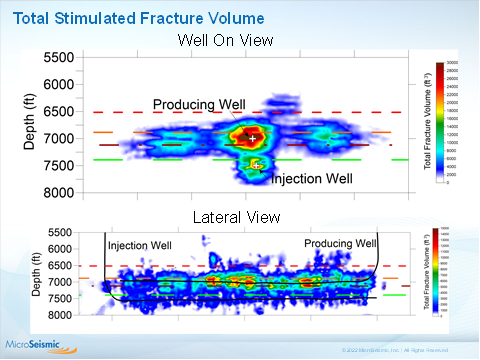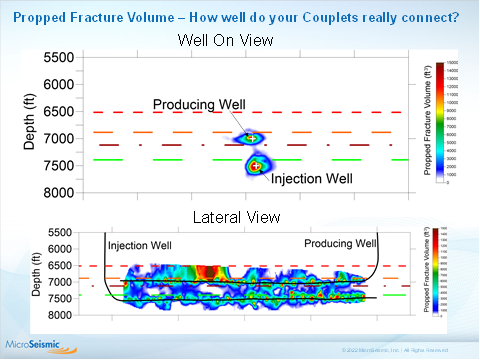/
The Challenge:
Hot Dry Rocks (HDR) are areas where geothermal can work better if naturally occurring fractures can be enlarged, extended, and enhanced allowing more fluid to connect with the HDR resulting in a much greater power output than is achieved by tradition geothermal systems. EGS works by injecting fluid and proppant into the HDR to greatly increase the long-term productive fracture network. Integral to this process is the ability to monitor this stimulation to quantify the newly propped fracture network and use this information to improve the stimulation of future wells.
With MicroSeismic, Inc’s advanced monitoring techniques driving your subsurface optimization, your EGS power plant can achieve maximum output.

EGS is all about stimulating the rock to get the optimal, long-term connectivity and drainage which comes from fractures filled with proppant.
Above, in this total fracture volume view as derived from conventional microseismic, this pair of wells appear to be connecting.

However, when you use our MicroThermal Energy Analysis to view the actual propped fracture volume, it’s clear they do not. Using this advanced data, future completions can be improved to ensure optimal well connectivity and maximum heat exchange!
Did you know?
We help our clients protect their assets, operations, and environment as the world transitions to new sources of renewable energy.
Geothermal energy, in simple terms, is the thermal energy (internal heat) within the earth that comes from planet formation, radioactive decay, and continental plate friction.
The principle of geothermal energy power production is, simply put, that one can harvest heat from the earth through hydraulic stimulation. Hydraulic stimulation can circulate cold fluids through hot rocks found at depth and return the warm fluids to the surface to drive turbines that generate electricity.
Limiting factors on this process include the temperature of the earth that can be economically accessed (the hotter the better) and the efficiency of the heat transfer in the rocks which is related to the permeability of the rock that is accessed.
Traditional geothermal power applications have used the natural fracture system in the rocks at depth to act as the conduits for the fluids that are being heated. Enhanced Geothermal Systems (EGS) are man-made reservoirs created by using the natural permeability of rock to induce more fractures into the hot rocks to increase surface area of hot rock contacted by the fluids thus increasing the efficiency of heat exchange and energy extraction. Today, modern hydraulic stimulation methodologies developed during the shale revolution are being ported to the geothermal industry in support of EGS, just as in hydrocarbon applications, such fracture processes need to be monitored to image the fractures created and ensure the proper development of an appropriately fractured reservoir for optimal heat exchange.


Avoid high temperatures with surface monitoring.
Why use MicroThermal Energy Monitoring:
Better Stimulation = Greener World!
Enhanced Geothermal Systems Monitoring (EGSM): We are the global leader in hydraulic stimulation monitoring (HSM) and our Advanced Engineering Analysis can quantify the success of a geothermal stimulation and give tangible insights to improve heat-rock connectivity on future injector/producer groupings.
Eliminate Risks: Our BuriedArrayTM can be installed for the life of the project and monitor Facture Connectivity, 3 and 4D and Induced Seismicity (ISM) as contained in section Four of the DOE’s Best Practices EGS Induced Seismicity 8-APR-2016.
Benefits:
- Surface based subsurface mapping and geologic data:
- eliminates downhole tools that can burn up.
- Optimize connectivity between injection and production wells
- Real-time induced seismicity monitoring.
- Available for almost any size area and can be expanded easily as needed.
Being the world leader in microseismic monitoring, MSI has the domain knowledge and experience to accomplish this imaging.
To learn more about MicroThermal Energy Monitoring, please contact
Analiese Andersen
VP of Geothermal Energy
[email protected]
262-391-2781

